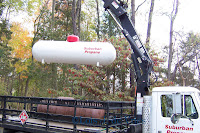Propane Tank in the Garden, Revisited

My karate teacher was fond of saying, “When you think you know, you don’t know.” Add in the old saws about not believing everything you hear and looks being deceiving, and you’ll understand why we changed our minds about moving our propane tank. (See original post at http://loisdevries.blogspot.com/2008/08/eyesores-in-garden.html ). It turned out not to be all that expensive: $50 for a permit; $40 for two trenching tools; and $106 for the propane company to send two installers and a boom truck to swap out the old tank for a new one. And we lucked out with the ledge --- we were able to dig down nearly a foot to create a new landing pad for the tank without hitting rock, even though the ledge juts out on either side of this spot. We dug and refilled the trench for the line to the house ourselves. There was one moment of trepidation when the installers told me that the boom wouldn’t reach the new site unless I let them drive their monstrous truck into my lavender garden. I hesita


